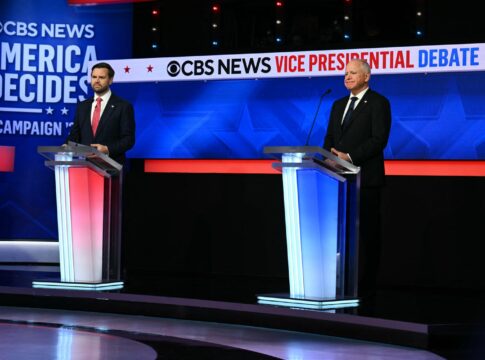Joker: Folie à Deux does not feature a battle with Batman. The sequel to 2019’s origin story—in which we learned how the ills of Gotham produced a demented clown—does not bring it all back to the eternal melodrama between Bruce Wayne and his fun-house mirror. Instead, the figure reaching into the depths of Joker’s soul is Harley Quinn, his sidekick, collaborator, and paramour, who is often drawn with quite a bit of levity in the DC universe. Here, though, she is given a tall order. Lady Gaga, who plays Harley, must interrogate how anyone could fall for one of fiction’s greatest villains. So she sings with him, joining her mezzo-soprano with his bass. She laughs at all his bad jokes. She scrawls a demon lipstick smile across his face. And occasionally, she helps quench his perennial thirst for vengeance. The film presents an argument that in order to truly understand the Joker, we must step into the shoes of someone who adores him. Though Folie à Deux is a failure for a whole host of reasons, it does succeed as a testament to Harley’s immense power as a character. How else could this minor villain from Batman’s immense rogues’ gallery become the second lead in one of the biggest movies of the year?
The improbability of the Harley Quinn renaissance can’t be understated, especially when you compare her with her peers. Superman was conceived in 1938, at a moment when the basic grammar of comic books was still being formulated. The team behind the character, author Jerry Siegel and artist Joe Shuster, blessed him with a bulletproof physique, Hollywood looks, and, most importantly, an indefatigable goody-two-shoes moral code. Superman was sent off to save Metropolis, and the superhero business has been reckoning with the undeniable blandness of its standard-bearer ever since. DC quickly attempted to mine new intrigue from the highly lucrative template it created. Batman—who made his debut a year later, in 1939—brought with him a more vulnerable, human exterior, but he too was defined by an alienating, single-minded desire for justice. Two years after that, Wonder Woman, the final member of the DC triumvirate, popped up with essentially the same gestalt as Superman—albeit with a heavier dose of American wartime patriotism (star-spangled knickers) and just a dash of BDSM. (Who wouldn’t like to get tied up by her Lasso of Truth?)
Eight decades later, all three of those characters continue to sell comic books and headline franchise films. (The return of Superman, after a series of turgid Henry Cavill projects, is set to herald a new era of DC-branded cinema next year.) And yet, for some reason, Harley Quinn has managed to keep up with—and sometimes eclipse—this holy trinity. In 2016, when DC reconstituted its timeline with the Rebirth promotion, Harley Quinn No. 1 reportedly sold 400,000 copies—more than any single Batman issue released that year. Shortly afterward, DC publisher Jim Lee christened Harley as the “fourth pillar” of the company’s brand, effectively thrusting her into the inner circle alongside those esteemed octogenarian Golden Age icons.
It was a bold assertion. Superman, Batman, and Wonder Woman sharing the same billing as a sidekick? A character who made her first appearance in the 1990s? But DC’s bet has paid off in spades. Today the Harley business is booming, with nearly the whole company structured around her charm. She buoyed both the slipshod 2016 Suicide Squad and its surprisingly delightful 2021 sequel, she continues to star in her own madcap Max series (soon to enter its fifth season) that consistently draws raves from critics, and when Birds of Prey tanked at the box office, Warner Bros. reportedly mandated a postrelease title adjustment to put the name of its top box-office draw, Miss Puddin’ herself, at the front. Along the way, the character attracted a collection of legitimate A-listers who’ve been eager to give voice to Harley’s winning brand of madness. Prior to Gaga donning her signature black checkers, Margot Robbie, Jenny Slate (in The Lego Batman Movie), and Kaley Cuoco (in Max’s animated series) have all helped elevate the character from the bowels of DC’s apocrypha, and with the imprint priming a major cinematic comeback—including two distinct Batman universes—more depictions are surely on the way. All of this is a total demolishing of the comic-book hierarchy. Twenty years ago, it would’ve been almost inconceivable that one of the world’s most famous actresses could feasibly court Oscar intrigue by playing the Joker’s face-painted femme fatale. In 2024, though, the casting seems almost compulsory, the logical follow-up to her co-star’s own Best Actor award.
Harley’s rise, then, could be read as either a break with superhero tradition or its long-awaited evolution. The character possesses none of the qualities we’ve come to expect from our spandex deities. Harley isn’t constrained by an exhausted sense of duty, or a maniacal desire to maintain order, or, especially, a fundamental need to do good. Nobody would think to light up the sky with a signal for Harley Quinn to save the world. In fact, in most of her stories, the only objective at hand is Harley’s own self-discovery. More than anything, that’s why she’s become the hero of our time.
Nobody saw this coming. The comic-book industry has historically struggled to mint new stars, resulting in the ossified gerontocracy that has held the superhero genre hostage for years. (Since 2000, we have somehow lived through four separate Spider-Man movie timelines. Even the Joker, who himself has passed through four movie universes over the same span, first appeared on the comic rack back in 1940.) But unlike her DC peers, and even the bulk of Marvel’s Avengers, Harley Quinn crawled out of the primordial soup long after superhero comics’ big bang. She debuted in 1992, as an ancillary criminal on Fox’s Batman: The Animated Series, and initially, she was slated for exactly one episode. Harley was positioned as the Joker’s psychopathic fangirl, stitched up in a red-and-black catsuit, dark lipstick, and a jester’s cap, which paired neatly with her boss’s purple tuxedo. Harley shared the Joker’s penchant for hysterical cruelty, but she went about her business with brassy Broadway panache—a villain motivated by a joyriding id rather than any dark theories about human nature. Harley was originally portrayed by Arleen Sorkin, a cabaret veteran, who based her performance off a scene in Days of Our Lives in which she played an indignant court jester desperate for laughs in front of her royal audience. That was Harley in a nutshell: alluring, dangerous, and a tad headstrong—a ham who’s decided to become a criminal.
“The combo of the visual and Arleen Sorkin’s performance, y’know, it was kind of magical,” said Bruce Timm, co-creator of Batman: The Animated Series, in an interview with Vulture years later. “[Writer] Paul [Dini] started immediately planning her return and saying, ‘Y’know what? I’m gonna bring that Harley Quinn character back.’ ”
He did, again and again, and with time, it became clear that Harley Quinn was destined to become the Joker’s other foil, a rival to the Caped Crusader. She made the jump from TV screens to the pages of DC’s comics in 1993, culminating with her first official origin story in the Eisner Award–winning 1994 one-shot The Batman Adventures: Mad Love. The book reveals that Harley Quinn was once an intern at Arkham Asylum named Harleen Quinzel, who attended the Joker’s therapy appointments and fell under his sway. After becoming fully indoctrinated—and utterly besotted—Quinzel helps her patient break out of the asylum and back into the lawless streets of Gotham. The pair could never resolve their wants and needs, leaving a vein of toxicity pulsating through their relationship. (In one memorable panel, we catch a glimpse of Harley’s domestic fantasy—getting married, raising a family of upstart supervillains, and growing old together—which is smashed to bits by the revelation that the Joker has only one true love, the Batman.) The tale brightened Harley’s undeniable charisma with a glint of sympathy. Who hasn’t been in love with the wrong person? Maybe, in another realm, Harley could’ve even been a hero.
It continued this way—Harley and Joker, Bonnie and Clyde, locked in spiraling codependency—for several more years, as the character wormed her way deeper into the heart of the DC universe. As time went on, the publisher also began removing her clothes. Harley was stripped of her bodysuit in the massively successful 2009 video game Batman: Arkham Asylum. Replacing it was a blood-splattered miniskirt, thigh-high boots, and a waist-cinching corset that exposes so much cleavage that it helped earn the game its not-for-the-kiddies rating. Harley’s sex appeal was relegated to subtext when she was anchoring a children’s TV show, but once she was pulled toward the grimier corners of the Batman universe, nothing was left to the imagination. DC took the minxification of Harley even further in 2011, when it put her on the cover of a Suicide Squad issue in a pinup silhouette: Gone were the blouse and skirt, leaving little more than skintight hot pants and a bursting bustier.
This was the last straw for some veteran Harley fans, who felt that DC had reduced one of the more interesting women on its roster into red meat for the male gaze. As Vulture reported, some dejected Harley-heads protested the redesign at that year’s Comic-Con. (“It’s that classic idea of ‘show us as much skin as possible because it’ll bring in those teenage boys,’ ” said one of the organizers.) Nonetheless, Harley’s unabashed sexuality stuck, and with the character more popular than she’s ever been, it certainly seems as if fans have come to accept her new look. Case in point: The Harley Quinn we see on her Max series scarcely appears without a bare midriff, and in Margot Robbie’s depiction, she infamously has a tattoo printed across her crotch that reads “Lucky you.”
Whatever you make of this lascivious design, DC has adroitly rounded it out with new subtleties in her character, all of which offer dimensions beyond thirst. Harley’s intense friendship with fellow Batman nemesis Poison Ivy, perpetually coded as Sapphic, has become an established fixture in the canon. (In both the comics and the Max series, the pair have been in a nonmonogamous relationship.) This also means Harley has broken up with the Joker and is finally rid of his corroding influence. She is no longer mired in a life of crime. She is experiencing the cathartic pleasures of healing. She even gets along with Batman now. In a land of psyche-blotting guilt and curdled revenge sagas—in which all heroes seem to be lugging around dead parents, slain uncles, or destroyed homeworlds—the only thing Harley seeks is her glow-up. She pursues joy, not justice. In one of the best scenes from The Suicide Squad, Harley is brought to tears after discovering that her friends dispatched a team to rescue her from a gang of mercenaries—albeit minutes after she gunned them all down herself. Harley realizes that she is capable of being loved. No wonder we connect with her.
And ultimately, this is why Gaga’s portrayal of the character falls flat. Joker: Folie à Deux ditches Harley’s long redemption arc to return her to her lowest: a woman enamored of a bad man. She is rendered a constellation in his universe, utterly transfixed, to the point that she’d kill on his behalf. This was indeed Harley Quinn, once upon a time. But frankly, if we’ve learned anything from her story so far, it’s that maybe she never needed the Joker after all.



